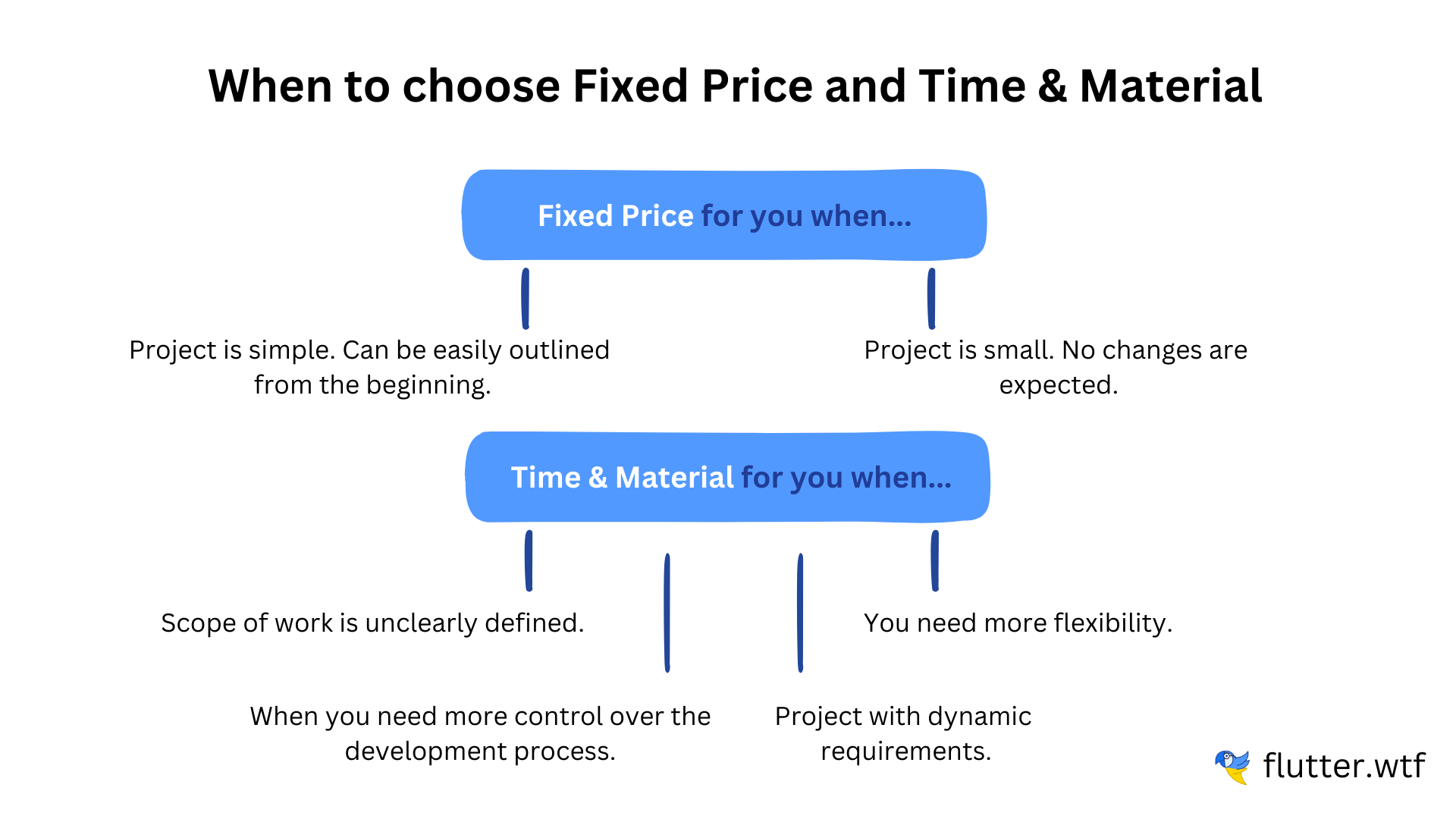In the dynamic world of mobile app development, choosing the right pricing model is not just about numbers—it's about aligning your project's vision, scope, and objectives with a financial structure that makes sense. Whether you're a budding entrepreneur with a groundbreaking app idea or an established business looking to expand your digital footprint, understanding the nuances of project pricing can make all the difference.
For those venturing into the realm of mobile app development, a common dilemma arises: should you opt for a Time and Material (T&M) model or a Fixed Price (FP) model? Each has its unique advantages, challenges, and use-cases. Making the right choice can be the difference between a smooth development process and unexpected challenges.
This comprehensive guide aims to demystify these two prevalent pricing models. We'll delve deep into their characteristics, weigh their pros and cons, and provide insights to help you determine which model aligns best with your project's needs. By the end of this exploration, you'll be equipped with the knowledge to make an informed decision, ensuring that your app development journey starts on the right foot.

Time and Material (T&M): Understanding the Basics
In the vast landscape of project management and app development, the pricing model you choose can significantly influence the trajectory of your project. It's not just about costs; it's about how those costs are calculated, managed, and communicated. Let's delve deeper into the first of our two primary models: Time and Material (T&M).
T&M: definition
Time and Material is a pricing model where clients are billed based on the actual time spent by the development team and the materials or resources used in the project. It's akin to paying for a service as you would for a craftsman's time and the materials they use.
T&M: pros and cons
| Aspect | Time and Material |
|---|---|
| Pros |
|
| Cons |
|
T&M: key features
- Flexibility in project adjustments: One of the standout features of the T&M model is its inherent flexibility. Since you're billed for actual work done, there's room to adjust the project's scope, make changes, or introduce new features as the development progresses. This is particularly beneficial for projects where the requirements might evolve or are not crystal clear from the outset.
- Transparent billing: With T&M, there's a high level of transparency in billing. Clients receive detailed breakdowns of hours worked, tasks completed, and resources used. This transparency ensures that you know exactly where every penny is spent, fostering trust between the client and the development agency.
- Suitable for long-term projects: Given its adaptable nature, T&M is often the go-to choice for long-term projects or those with evolving requirements. As the project progresses and the market dynamics change, there's room to pivot or refine the app's features without undergoing cumbersome contractual changes.
- Dynamic team allocation: Unlike fixed-price models where resources are often set in stone, T&M allows for dynamic team allocation. This means that based on the project's current needs, you can ramp up or scale down the team. Need more designers for a particular phase? Or perhaps a few extra developers to expedite a module? T&M provides that flexibility.

T&M: when to choose
The Time and Material model shines brightest in the following situations:
- Evolving requirements: If your project is in a domain where requirements are expected to change or evolve based on feedback, market conditions, or other factors, T&M offers the flexibility you need.
- Long-term projects: For projects that span over a longer duration, where predicting every requirement from the start is challenging, T&M provides the adaptability to accommodate changes.
- Uncertain scope: If you're venturing into a new domain or if the project's scope isn't crystal clear from the outset, T&M allows for adjustments without the need for constant renegotiations.
- Collaborative approach: T&M is ideal when clients wish to be closely involved in the development process, offering feedback, and making decisions on-the-go.
- Quality over speed: If the primary focus is on achieving top-notch quality, even if it means adjusting timelines based on the challenges encountered, T&M ensures that developers aren't rushed by strict deadlines.
T&M: in-depth look
The T&M model can be visualized as a journey where the destination is known, but the path isn't strictly defined. You have a goal in mind, but you're open to taking detours, exploring new avenues, or even changing the destination based on new insights or challenges. This approach is collaborative, with the development team and client working closely, iterating, and refining the project as it unfolds.
However, with this flexibility comes the responsibility of regular monitoring and active involvement. Since there's no fixed price cap, projects can potentially exceed initial budget estimates if not managed effectively. It's a model that thrives on trust, communication, and a shared vision for the end product.
Fixed Price (FP): Understanding the Basics
In the vast landscape of project payment models, the Fixed Price (FP) model stands out for its simplicity and clarity. At its core, FP offers a predetermined cost for the entire project, ensuring that both clients and developers have a clear financial roadmap from the outset. But what makes it tick, and is it the right choice for your project? Let's delve into the foundational aspects of the Fixed Price model to better understand its nuances and benefits.
FP: definition
The Fixed Price model is a pricing strategy where the total cost of the project is agreed upon and set in stone before the development begins. Regardless of the time and resources expended, the price remains unchanged, offering a predictable budgeting framework for clients.
FP: pros and cons
| Aspect | Fixed Price |
|---|---|
| Pros |
|
| Cons |
|
FP: key features
- Clear budget from the start: One of the primary attractions of the FP model is budget certainty. Clients know the exact cost upfront, ensuring there are no surprises or hidden fees down the line. This clarity is especially beneficial for businesses with strict budget constraints or those seeking external funding based on projected expenses.

- Defined scope and deliverables: With a fixed price, the project's scope, milestones, and deliverables are clearly outlined from the outset. This clarity ensures that both the client and the development team have a shared understanding of what's expected, minimizing potential misunderstandings or scope creep.
- Ideal for short-term projects with a clear vision: Given its structured nature, FP is often the preferred choice for short-term projects or those with well-defined requirements. Whether it's a promotional app for an event or a specific tool for internal use, when the project's vision is clear, FP can be a straightforward and effective approach.
- Low client supervision: Since the scope and deliverables are predetermined, clients can adopt a more hands-off approach. The development team takes the reins, working towards the agreed-upon goals without requiring constant client input or adjustments.
FP: when to choose
The Fixed Price model is most suitable in scenarios where:
- Clear requirements: The project's scope, requirements, and deliverables are well-defined from the start.
- Limited flexibility: The client is confident that there won't be significant changes or additions to the project requirements.
- Budget constraints: There's a strict budget in place, and the client prefers to avoid any unforeseen expenses.
- Short to medium duration projects: Projects that are relatively short or have a medium duration often benefit from a fixed price due to the clarity it provides in terms of timeline and costs.
FP: in-depth look
Imagine the Fixed Price model as a train journey with a set destination and a clear track. The route is predetermined, the stops are scheduled, and the arrival time is projected. There's little room for deviation, but passengers (clients) can sit back and enjoy the ride, confident in their arrival at the predetermined destination.
However, this rigidity can be a double-edged sword. While it offers predictability, it can also be restrictive. Any changes to the project's scope or features can result in additional costs or extended timelines. Moreover, if unforeseen challenges arise during development, the onus is on the development agency to address them without altering the agreed-upon price. This can sometimes lead to situations where quality might be compromised to stay within budget.
Furthermore, the initial phase of a Fixed Price project often involves extensive discussions, negotiations, and documentation to ensure that every detail is captured and agreed upon. This can extend the project's kickoff time but ensures smoother execution once development begins.
Fixed Price vs Time and Materials: Main Differences
Each of the models described above has its unique advantages and is suited to different types of projects. Let's delve into the key differences between these two models to help you make an informed decision.
| Criteria | Fixed Price | Time and Materials |
|---|---|---|
| Pricing Structure | Pre-determined cost for the entire project. | Costs based on actual time and resources used. |
| Flexibility | Limited; changes can lead to renegotiations or additional costs. | High; allows for project modifications without renegotiating the entire contract. |
| Budget Predictability | High; cost is known upfront. | Variable; costs can escalate if it is unclear how many final tasks will be completed. |
| Client Involvement | Low; once requirements are set, clients can take a backseat. | High; clients need to be more involved to ensure the project stays on track. |
| Project Scope | Needs to be well-defined from the start. | Can evolve and adapt as the project progresses. |
| Quality vs. Speed | Potential risk of compromised quality to meet fixed deadlines. | Developers can focus on quality without being rushed by a fixed deadline. |
Real-World Scenarios: Which Model to Choose?
The theoretical differences between Fixed Fee and Time and Materials are clear, but how do they play out in real-world scenarios? Let's explore some common situations and determine which model might be the best fit.

1. Startup launching a MVP:
- Scenario: A startup wants to launch a new app but isn't entirely sure about all the features they want to include. They have a basic idea and want to test the waters before fully committing.
- Best fit: Time and Materials. Given the uncertainty and potential for change, T&M offers the flexibility startups need for MVPs.

2. Established company rolling out a standard update:
- Scenario: A well-established company needs to roll out a standard software update across all its branches. The requirements are clear, and there's little to no room for changes.
- Best fit: Fixed Price. With clear requirements and no expected changes, this model offers budget predictability.
3. A local government's digital transformation project:
- Scenario: A local government body is looking to digitize its services. While they have a broad vision, the specifics might evolve based on citizen feedback and changing regulations.
- Best fit: Time and Materials. Given the long-term nature and potential for evolving requirements, T&M provides the necessary adaptability.
4. E-commerce business implementing a pre-built solution:
- Scenario: An e-commerce business wants to implement a well-known CRM solution. The requirements are standard, and the implementation process is well-documented.
- Best fit: Fixed Price. The clarity in requirements and the standardized nature of the task make the Fixed Fee model a logical choice.
5. Agency building a customized marketing campaign:
- Scenario: A brand hires an agency to craft a unique, year-long marketing campaign. The brand has some ideas but wants the agency to experiment and adjust based on market response.
- Best Fit: Time and Materials. The experimental nature of the project and the need for ongoing adjustments make T&M the ideal choice.
6. Development of a niche software with uncertain requirements:
- Scenario: A company wants to develop a niche software solution. The idea is innovative, but the technical requirements and challenges are not fully understood at the outset.
- Best fit: Time and Materials. Given the uncertainties and potential technical challenges that might arise, T&M offers the flexibility to navigate the project as it unfolds.
Conclusion
Navigating the intricate world of pricing models, especially between Fixed Fee and Time and Materials, requires a blend of introspection and foresight. Each model, with its unique strengths and challenges, caters to different project dynamics and client preferences. The choice isn't about determining which model is superior, but rather which aligns best with the specific nuances of your endeavor.
By understanding the core attributes of each model and aligning them with your project's needs, you pave the way for a harmonious development process, ensuring both financial prudence and project success. Remember, in the realm of project management and development, a well-informed decision is always the cornerstone of success.
Ready to embark on your Flutter development journey? At What the Flutter, we're here to guide you every step of the way. Whether you're still weighing pricing models or ready to dive into development, our team of experts is eager to assist. Reach out to us today and let's bring your vision to life!












